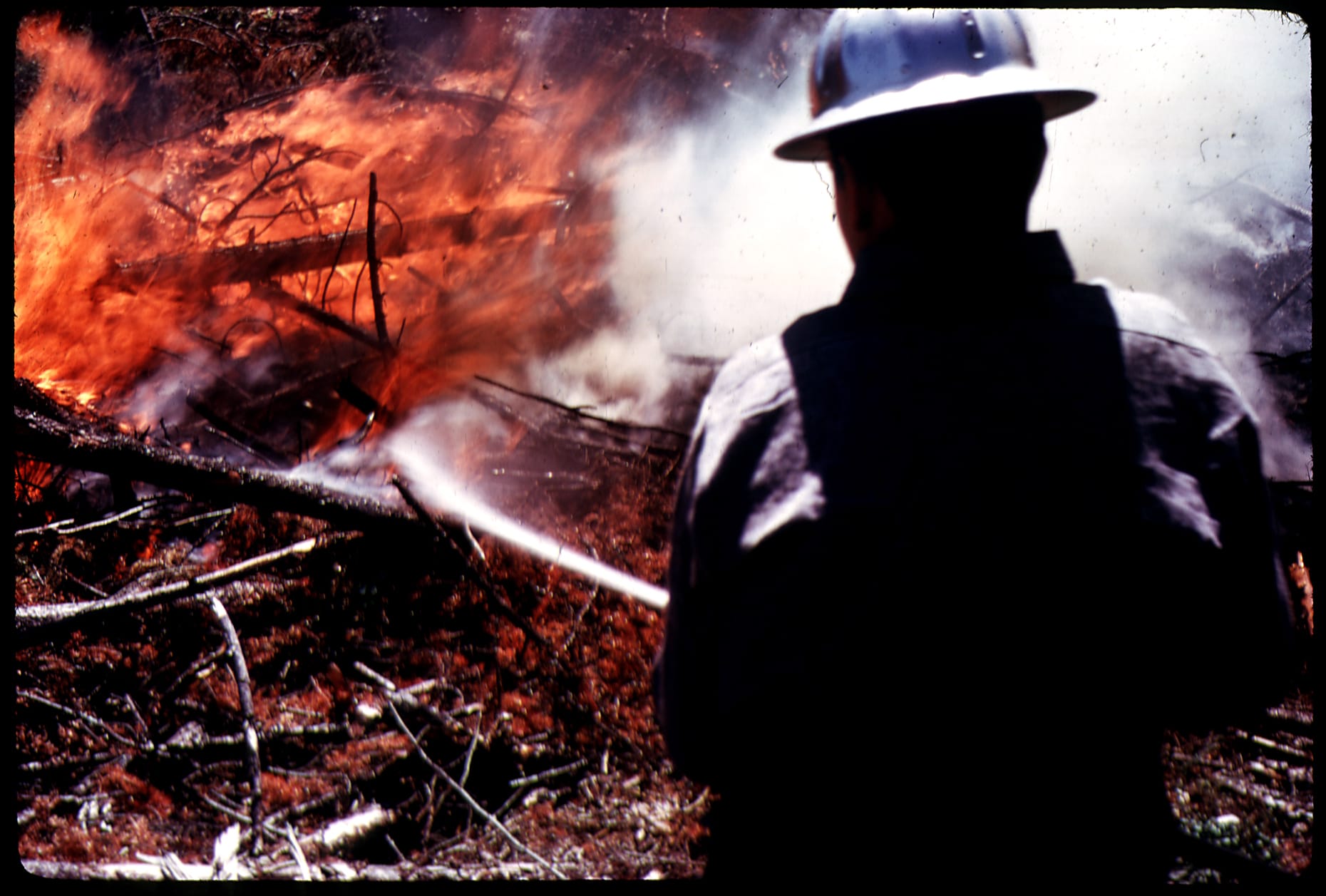Late in August, The Columbian asked local former wildland firefighters to share their memories and stories from working on the fireline. Multiple readers called, wrote and commented about their experiences:
Bob Lofgren
Bob Lofgren and his crew hitched a ride down the Snake River in jet boats at nighttime, with fire was burning on both sides of the canyon. It was the summer of 1960, there was a fire in Hell’s Canyon and that was the only way to get to it, he said.
The next morning, after a few hours of sleep, they climbed up the canyon and started fighting fire.
“Just ask me what is the deepest canyon in North America,” he said.
Lofgren spent three fire seasons, from 1960-1962, with the U.S. Forest Service, working out of Government Camp, Ore.
There were no roads around Hell’s Canyon, so the several fire crews on the scene had their meals delivered by parachute for 10 days.
Food came in the form of C-rations, which tasted fairly ordinary, but he said the coffee, which came in 5-gallon tins, always tasted a bit like diesel.
Lofgren and his friends also endured a couple off-target fire retardant drops.
“We were supposed to take cover when that happened, but having the pink borate solution spattered on your hard hat was considered cool,” he said.
Lofgren was on a crew of 14 firefighters. They were all seasonal workers, save the crew boss, and were college students, most local, but some from forestry programs back east.
“For me, it was summer work to help with tuition and other school expenses,” he said. For his first summer, they were paid $1.94 per hour, and worked 15 hour days, on average.
At the start of the season, they’d do two weeks of hard training. For one drill, they’d dig a fireline up a steep ridge, run down it, then run back up, then dig a line down.
Encounters with rattlesnakes, bears and other critters weren’t unusual. In his three years on the crew, injuries were rare, Lofgren said, and only one person was hurt badly: His crew boss was taken by helicopter from the side of a ridge near Wenatchee after a large rock struck him in the back.
“Another time, we hiked into a fire, and had been there an hour when smokejumpers started dropping down all around us,” he said. “They wondered what the hell we were doing there already. We said they were too late, go home.”
In July, he saw one of his old crew mates, Dave Moore, in the obituaries section of the newspaper. It’s the first of the old crew he’s seen there, he said.
“I hadn’t seen him for a long time. Too long,” Lofgren said. “Remembering him as I do, I know he enjoyed telling tales of his forest firefighting adventures to his grandkids, just like me.”
Lanny Allmaras
Lanny Allmaras worked fighting wildfires for more than 40 years, 32 with the U.S. Forest Service, and he got his start in Southwest Washington.
Later, he moved into working with helicopters, and, for a time, worked as a national aerial attack specialist before ending his public service career.
After that, he worked with a contract air tanker company.
Yes, there are hair-raising moments fighting fire, he said. “All too often, I think people make it out to be something that it isn’t,” he said. “It’s just a lot of damn hard work, generally speaking.”
There’s a lot of waiting around to do something, he said.
“And then, all of a sudden, you’re supposed to leap into action and do something, and half the time it turns out to be a fizzle.”
Still, he said, he had a great time doing it.
Bob Berrigan
One hairy moment Bob Berrigan recalled from his roughly 10 seasons as a firefighter came when he was fighting a fire around a logging operation.
When the fallen trees in the area caught fire, their branches burned. Berrigan and his co-workers with the State Department of Natural Resources were working around a hillside, and without their branches, the trees didn’t have much besides their heft to keep them from sliding down the hill.
Naturally, Berrigan said, one gave way.
“All of a sudden, there’s a torpedo coming down the mountain at you,” he said. “That was pretty exciting. Thankfully, no one got hurt.”
On another fire, he remembered, he worked in 40 mph winds.
It was too windy to put a fireline anywhere near the business end of the fire, he said, so they tried going around its back end, working up a big, rocky hillside.
In the middle of the night, they felt the wind shift and start blowing in the opposite direction.
“And we know the whole thing is running right at us,” he said.
Their planned escape route was down the hill and to a clearing other firefighters had built, he said, so they started running.
By the time they got down the hill, the fire had turned back the other way. Before switching directions, the fire reached the control line they were digging, he said, and the line held.
“We felt pretty good about our line, but I’ve never seen a fire do that so abruptly and go back to what it was doing,” he said.
It was scary at the time, he said, but it makes for a good story looking back.
Berrigan worked with the DNR from 1988 to 1998. He now teaches at Heritage High School, and said his students always perk up for fire stories.
“Of all the different things that I’ve done in my life, the firefighting thing is the one that gets their attention,” he said.
Dick Fenn
Before the outfit’s firefighting duties were folded in with the state, Dick Fenn fought wildfire as part of his time with the Clackamas-Marion Forest Protection Association in Oregon.
“It was a blast,” he said.
Sometimes, he said, people seem to get the wrong idea about what fire season is like for the scores of summer workers out there. He remembered there wasn’t always fires to fight, but there was always work to do.
From 1957 to 1963, he cleared trails, worked along graders fixing roads, helped with occasional search and rescue operations and did all manner of other work near Silver Creek Falls in Oregon.
“It sounds like they don’t do anything other than fight fire,” he said. “They do a lot of stuff.”
Dave Campbell
Before his 32 years as a volunteer and commissioner with Clark County Fire District 3, Dave Campbell was a forestry student at the University of California, Berkeley.
One night at a forestry summer camp during his junior or senior year, around 1955, the camp received word their help was needed at a wildfire about three hours away, on the Plumas National Forest in Northern California.
“(Getting) there by around 5 a.m. meant getting on a school bus around oh-dark thirty,” Campbell said. “A couple hours’ sleep, make ourselves some sandwiches to tide us over in case we missed breakfast, grab our hard hats and a jacket and off we went.”
He was 3-for-4 — no jacket — when they hit the road, he said.
It was still dark when they arrived at the fire camp, and Campbell and the others stumbled around until someone noticed them and gave them an assignment.
He was tasked with scouting around the north end of the fire to radio back how it looked.
“I was given the ‘portable’ radio, all 25 pounds of it strapped to a pack board, and then was pointed in the direction that I was to go,” he said.
“It was hot, the wind was coming up and the fire was getting hotter. This was my first experience with wildland fires, so everything was new and a little bit scary.”
Where they were, on the plateau above the slope up from U.S. Highway 395, the firefighters were somewhat in the front of the fire.
“Not a good place to be,” he said.
He got to the north side but couldn’t see through all the smoke. He radioed in and was told to beat it down the slope to the bottom to try getting a better view. After about a mile of marching through the brush, he arrived at the flats along the highway.
From there, he could see the fire was burning through the canopy north and west.
“Right where I had just crossed over and down the hill just an hour or so ago,” he said. “The rest of the crews evacuated to the south to get out of the way of the front and here I was, all by myself down at the bottom where the thing had started.”
All he had was a sandwich and a radio, which had died sometime while he was stumbling down the hill.
It was dark again when a Forest Service pickup came by looking for him, he said.
“Finally someone had become a little concerned about not hearing from me, and thought that I might have gotten caught in the fire. About three or four hours later, we finally made it back to the new fire camp,” he said. “That was one long day for a newbie, and I never did find my jacket.”




